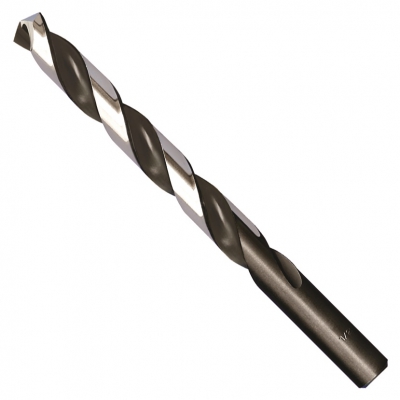
Alfa Tools offers Blitz Nitride jobber drills for heavy-duty production work, as well as tough maintenance (MRO) applications. These extra heavy-duty drills can tackle applications in the widest range of materials, including mild steel, stainless steel, titanium and nickel alloy steels, as well as nonferrous materials.
Blitz Nitride drills are made from premium M-7 molybdenum HSS with a special nitride treatment to give additional hardness to the cutting edge that lasts longer and outperforms cobalt tools, according to the company. The black oxide and silver finish increases lubricity and reduces friction. The strong web construction provides greater strength and rigidity to get through hard-to-drill materials like stainless steel and titanium alloys.
“Heavy-duty drills are essential to production and the MRO professional,” said Shaan Ahluwalia, vice president of sales and marketing at Alfa Tools. “Our Blitz Nitride jobber drills are resistant to wear, which ultimately means the end user gets the lowest cost per hole drilled.”
The split point and flute geometry make the Blitz Nitride drills cut cleanly and accurately with less effort, reducing user fatigue. These drill bits also withstand a high degree of heat at high speeds, which reduces friction and enables balanced cutting action with close hole tolerances. The precision-ground 135° split point is self-centering and reduces thrust for more efficient drilling.
Blitz Nitride jobber drill bits are available in steel indexes from 1/16” – ½” in 64th increments. Alfa also offers 13-, 15-, 21- and 29-piece sets. Additionally, they are available in a 29-piece plastic drill mug set.
Contact Details
Related Glossary Terms
- alloy steels
alloy steels
Steel containing specified quantities of alloying elements (other than carbon and the commonly accepted amounts of manganese, sulfur and phosphorus) added to cause changes in the metal’s mechanical and/or physical properties. Principal alloying elements are nickel, chromium, molybdenum and silicon. Some grades of alloy steels contain one or more of these elements: vanadium, boron, lead and copper.
- alloys
alloys
Substances having metallic properties and being composed of two or more chemical elements of which at least one is a metal.
- black oxide
black oxide
Black finish on a metal produced by immersing it in hot oxidizing salts or salt solutions.
- fatigue
fatigue
Phenomenon leading to fracture under repeated or fluctuating stresses having a maximum value less than the tensile strength of the material. Fatigue fractures are progressive, beginning as minute cracks that grow under the action of the fluctuating stress.
- hardness
hardness
Hardness is a measure of the resistance of a material to surface indentation or abrasion. There is no absolute scale for hardness. In order to express hardness quantitatively, each type of test has its own scale, which defines hardness. Indentation hardness obtained through static methods is measured by Brinell, Rockwell, Vickers and Knoop tests. Hardness without indentation is measured by a dynamic method, known as the Scleroscope test.
- high-speed steels ( HSS)
high-speed steels ( HSS)
Available in two major types: tungsten high-speed steels (designated by letter T having tungsten as the principal alloying element) and molybdenum high-speed steels (designated by letter M having molybdenum as the principal alloying element). The type T high-speed steels containing cobalt have higher wear resistance and greater red (hot) hardness, withstanding cutting temperature up to 1,100º F (590º C). The type T steels are used to fabricate metalcutting tools (milling cutters, drills, reamers and taps), woodworking tools, various types of punches and dies, ball and roller bearings. The type M steels are used for cutting tools and various types of dies.
- lubricity
lubricity
Measure of the relative efficiency with which a cutting fluid or lubricant reduces friction between surfaces.
- web
web
On a rotating tool, the portion of the tool body that joins the lands. Web is thicker at the shank end, relative to the point end, providing maximum torsional strength.






